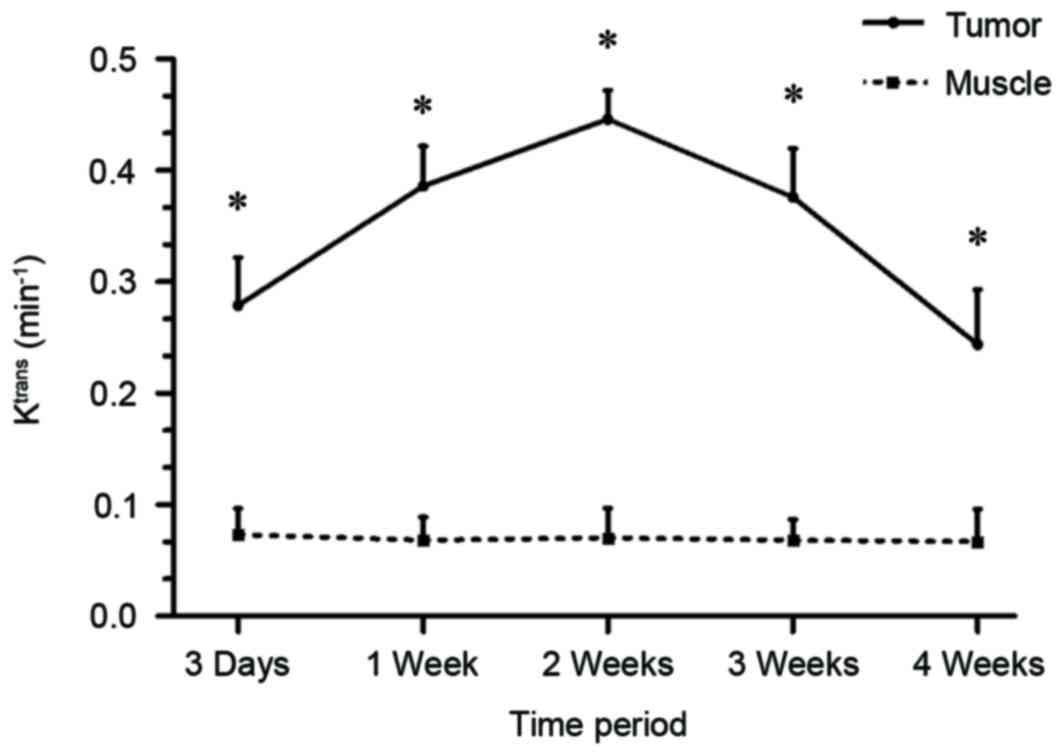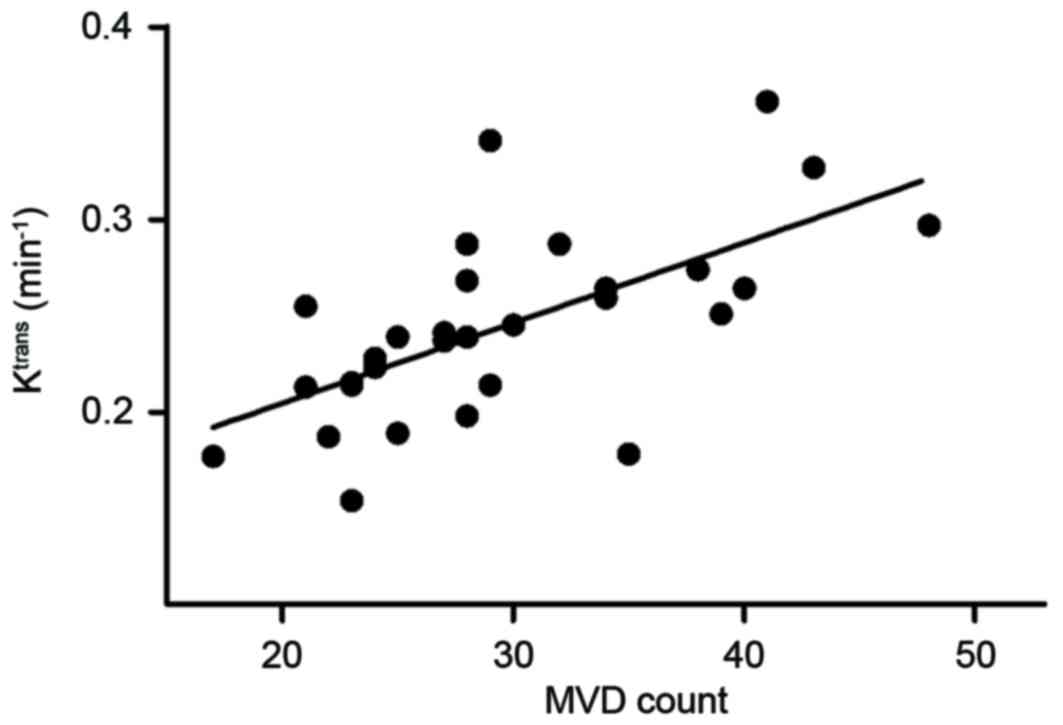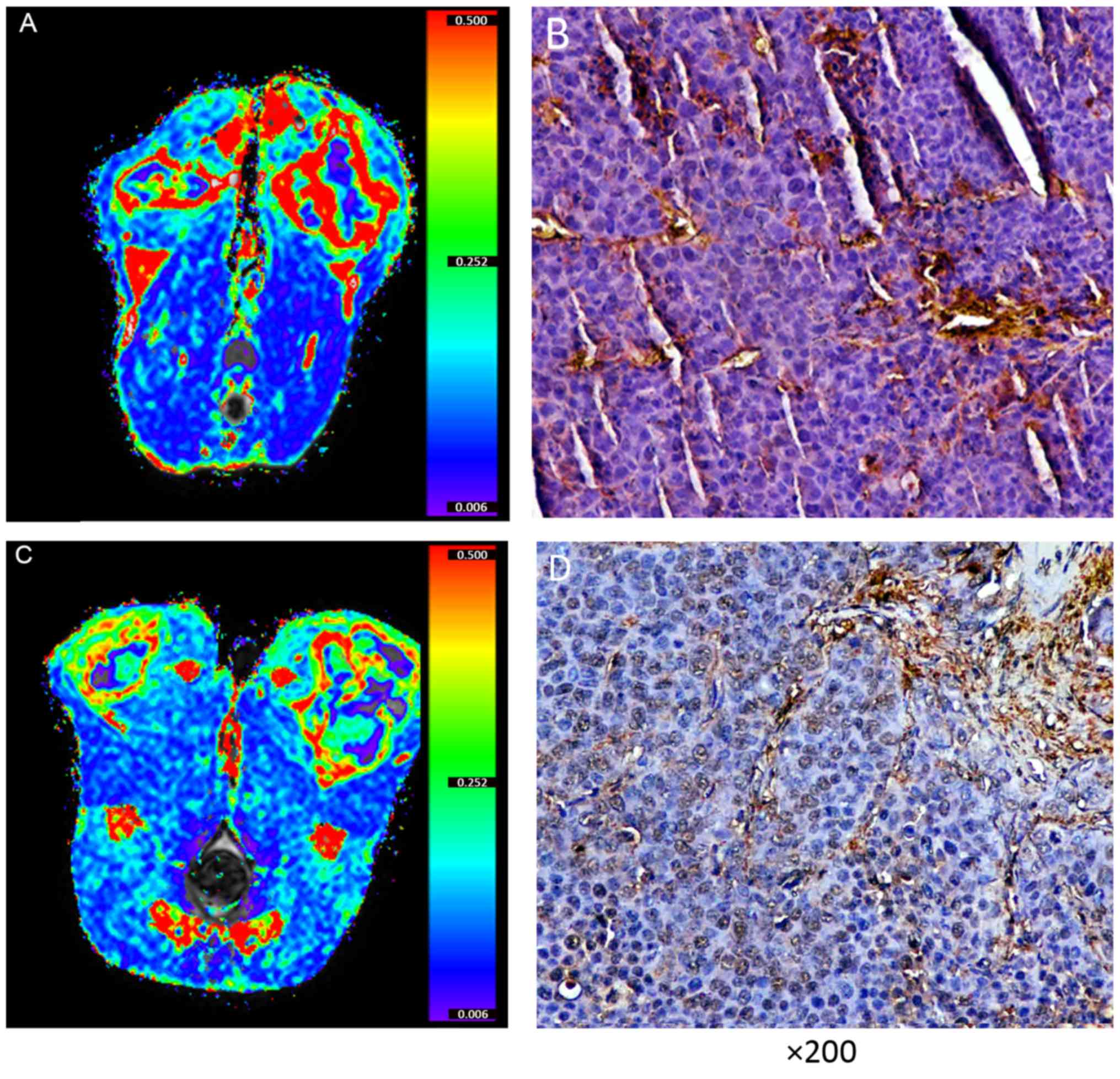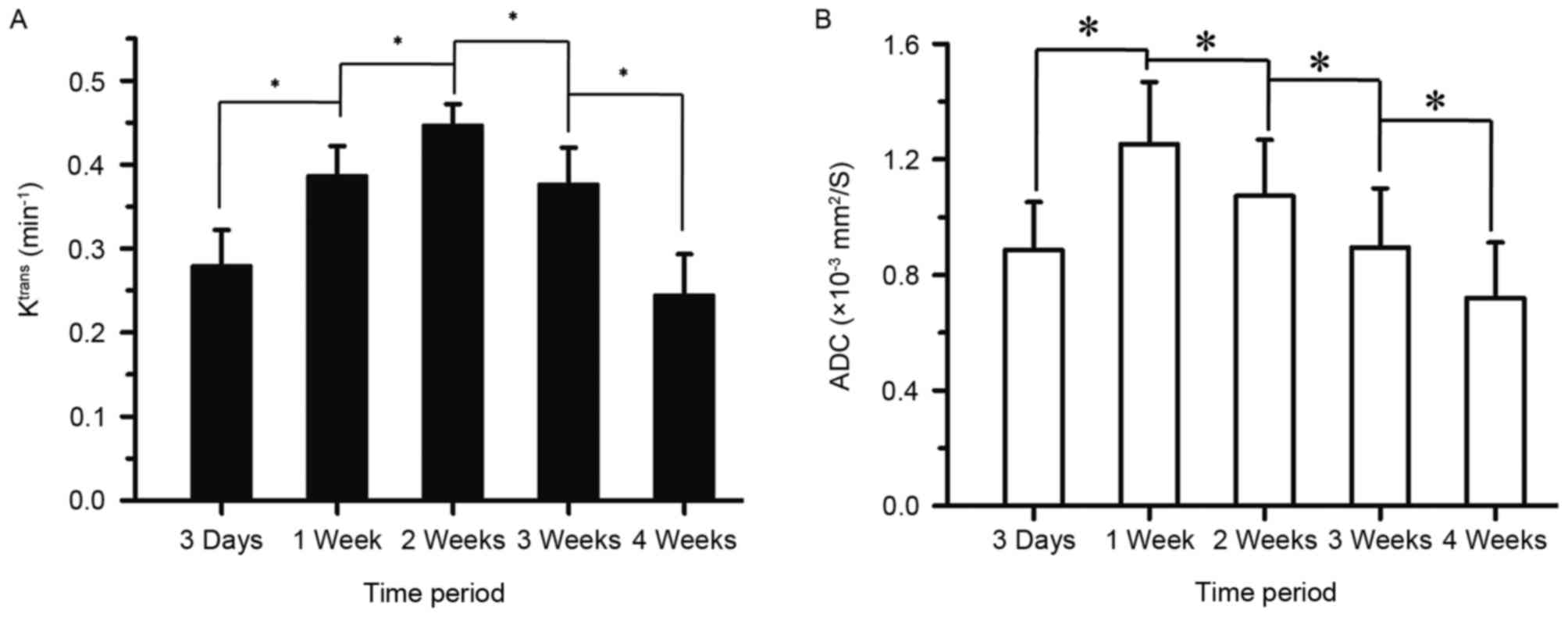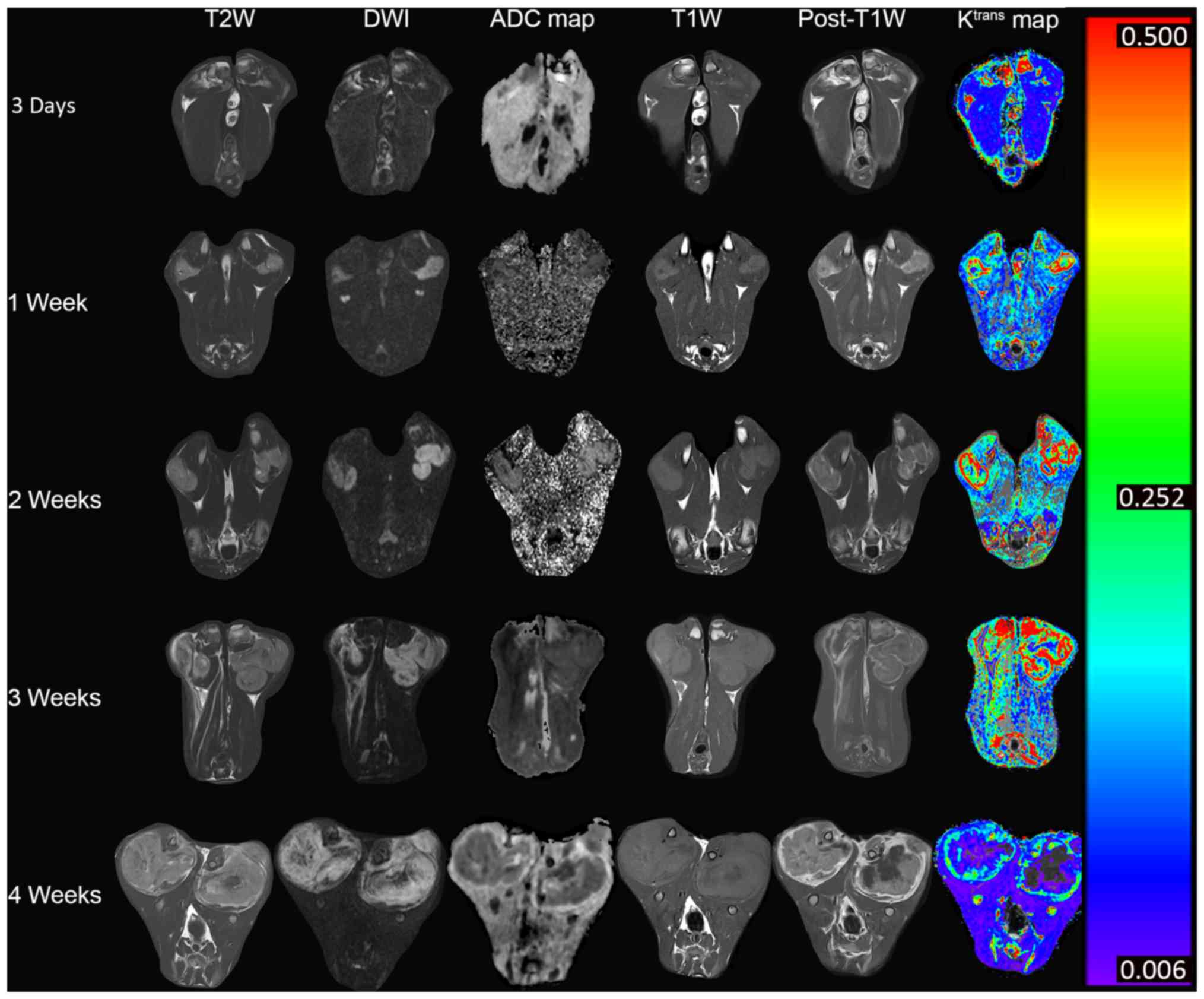|
1
|
Folkman J: Role of angiogenesis in tumor
growth and metastasis. Semin Oncol. 29(6 Suppl 16): S15–S18. 2002.
View Article : Google Scholar
|
|
2
|
Iagaru A and Gambhir SS: Imaging tumor
angiogenesis: The road to clinical utility. AJR Am J Roentgenol.
201:W183–W191. 2013. View Article : Google Scholar : PubMed/NCBI
|
|
3
|
Nomura T, Hirata K, Shimaoka T, Yamakawa
M, Koizumi N, Suzuki R, Maruyama K and Utoguchi N: Cancer vaccine
therapy using tumor endothelial cells as antigens suppresses solid
tumor growth and metastasis. Biol Pharm Bull. 40:1661–1668. 2017.
View Article : Google Scholar : PubMed/NCBI
|
|
4
|
Gerstner ER, Emblem KE and Sorensen GA:
Vascular magnetic resonance imaging in brain tumors during
antiangiogenic therapy-are we there yet? Cancer J. 21:337–342.
2015. View Article : Google Scholar : PubMed/NCBI
|
|
5
|
Chen J, Qian T, Zhang H, Wei C, Meng F and
Yin H: Combining dynamic contrast enhanced magnetic resonance
imaging and microvessel density to assess the angiogenesis after
PEI in a rabbit VX2 liver tumor model. Magn Reson Imaging.
34:177–182. 2016. View Article : Google Scholar : PubMed/NCBI
|
|
6
|
Pinto MP, Owen GI, Retamal I and Garrido
M: Angiogenesis inhibitors in early development for gastric cancer.
Expert Opin Investig Drugs. 26:1007–1017. 2017. View Article : Google Scholar : PubMed/NCBI
|
|
7
|
Peng FW, Liu DK, Zhang QW, Xu YG and Shi
L: VEGFR-2 inhibitors and the therapeutic applications thereof: A
patent review (2012–2016). Expert Opin Ther Pat. 27:987–1004. 2017.
View Article : Google Scholar : PubMed/NCBI
|
|
8
|
Chen HF and Wu KJ: Endothelial Trans
differentiation of tumor cells triggered by the Twist1-Jagged1-KLF4
Axis: Relationship between Cancer Stemness and Angiogenesis. Stem
Cells Int. 2016:64398642016. View Article : Google Scholar : PubMed/NCBI
|
|
9
|
Bremnes RM, Camps C and Sirera R:
Angiogenesis in non-small cell lung cancer: The prognostic impact
of neoangiogenesis and the cytokines VEGF and bFGF in tumours and
blood. Lung Cancer. 51:143–158. 2006. View Article : Google Scholar : PubMed/NCBI
|
|
10
|
Mischi M, Turco S, Lavini C, Kompatsiari
K, de la Rosette JJ, Breeuwer M and Wijkstra H: Magnetic resonance
dispersion imaging for localization of angiogenesis and cancer
growth. Invest Radiol. 49:561–569. 2014. View Article : Google Scholar : PubMed/NCBI
|
|
11
|
Jia WR, Chai WM, Tang L, Wang Y, Fei XC,
Han BS and Chen M: Three-dimensional contrast enhanced ultrasound
score and dynamic contrast-enhanced magnetic resonance imaging
score in evaluating breast tumor angiogenesis: Correlation with
biological factors. Eur J Radiol. 83:1098–1105. 2014. View Article : Google Scholar : PubMed/NCBI
|
|
12
|
McCarville MB, Coleman JL, Guo J, Li Y, Li
X, Honnoll PJ, Davidoff AM and Navid F: Use of quantitative dynamic
Contrast-Enhanced ultrasound to assess response to antiangiogenic
therapy in children and adolescents with solid malignancies: A
pilot study. AJR Am J Roentgenol. 206:933–939. 2016. View Article : Google Scholar : PubMed/NCBI
|
|
13
|
Nedelcu RI, Zurac SA, Brînzea A, Cioplea
MD, Turcu G, Popescu R, Popescu CM and Ion DA: Morphological
features of melanocytic tumors with depigmented halo: Review of the
literature and personal results. Rom J Morphol Embryol. 56(2
Suppl): S659–S663. 2015.
|
|
14
|
Arteaga-Marrero N, Rygh CB, Mainou-Gomez
JF, Nylund K, Roehrich D, Heggdal J, Matulaniec P, Gilja OH, Reed
RK, Svensson L, et al: Multimodal approach to assess tumour
vasculature and potential treatment effect with DCE-US and DCE-MRI
quantification in CWR22 prostate tumour xenografts. Contrast Media
Mol Imaging. 10:428–437. 2015. View Article : Google Scholar : PubMed/NCBI
|
|
15
|
Razek AA, Megahed AS, Denewer A, Motamed
A, Tawfik A and Nada N: Role of diffusion-weighted magnetic
resonance imaging in differentiation between the viable and
necrotic parts of head and neck tumors. Acta Radiol. 49:364–370.
2008. View Article : Google Scholar : PubMed/NCBI
|
|
16
|
Ludwig JM, Camacho JC, Kokabi N, Xing M
and Kim HS: The role of Diffusion-weighted imaging (DWI) in
Locoregional therapy outcome prediction and response assessment for
hepatocellular carcinoma (HCC): The New Era of Functional imaging
biomarkers. Diagnostics (Basel). 5:546–563. 2015. View Article : Google Scholar : PubMed/NCBI
|
|
17
|
International Council for Laboratory
Animal Science (ICLAS), . http://www.iclas.orgJuly 13–2012
|
|
18
|
Tofts PS, Brix G, Buckley DL, Evelhoch JL,
Henderson E, Knopp MV, Larsson HB, Lee TY, Mayr NA, Parker GJ, et
al: Estimating kinetic parameters from dynamic contrast-enhanced
T(1)-weighted MRI of a diffusable tracer: Standardized quantities
and symbols. J Magn Reson Imaging. 10:223–232. 1999. View Article : Google Scholar : PubMed/NCBI
|
|
19
|
Weidner N: Current pathologic methods for
measuring intratumoral microvessel density within breast carcinoma
and other solid tumors. Breast Cancer Res Treat. 36:169–180. 1995.
View Article : Google Scholar : PubMed/NCBI
|
|
20
|
Hida K, Hida Y and Shindoh M:
Understanding tumor endothelial cell abnormalities to develop ideal
anti-angiogenic therapies. Cancer Sci. 99:459–466. 2008. View Article : Google Scholar : PubMed/NCBI
|
|
21
|
Lijowski M, Caruthers S, Hu G, Zhang H,
Scott MJ, Williams T, Erpelding T, Schmieder AH, Kiefer G, Gulyas
G, et al: High sensitivity: High-resolution SPECT-CT/MR molecular
imaging of angiogenesis in the Vx2 model. Invest Radiol. 44:15–22.
2009. View Article : Google Scholar : PubMed/NCBI
|
|
22
|
Feng G, Lei Z, Wang D, Xu N, Wei Q, Li D
and Liu J: The evaluation of anti-angiogenic effects of Endostar on
rabbit VX2 portal vein tumor thrombus using perfusion MSCT. Cancer
Imaging. 14:172014.PubMed/NCBI
|
|
23
|
Manzo A, Montanino A, Carillio G, Costanzo
R, Sandomenico C, Normanno N, Piccirillo MC, Daniele G, Perrone F,
Rocco G and Morabito A: Angiogenesis Inhibitors in NSCLC. Int J Mol
Sci. 18:pii: E20212017. View Article : Google Scholar
|
|
24
|
Folkman J: What is the evidence that
tumors are angiogenesis dependent. J Natl Cancer Inst. 82:4–6.
1990. View Article : Google Scholar : PubMed/NCBI
|
|
25
|
Thoeny HC, De Keyzer F, Vandecaveye V,
Chen F, Sun X, Bosmans H, Hermans R, Verbeken EK, Boesch C, Marchal
G, et al: Effect of vascular targeting agent in rat tumor model:
Dynamic contrast-enhanced versus diffusion-weighted MR imaging.
Radiology. 237:492–499. 2005. View Article : Google Scholar : PubMed/NCBI
|
|
26
|
Panagiotaki E, Walker-Samuel S, Siow B,
Johnson SP, Rajkumar V, Pedley RB, Lythgoe MF and Alexander DC:
Noninvasive quantification of solid tumor microstructure using
VERDICT MRI. Cancer Res. 74:1902–1912. 2014. View Article : Google Scholar : PubMed/NCBI
|
|
27
|
Chen FH, Wang CC, Liu HL, Fu SY, Yu CF,
Chang C, Chiang CS and Hong JH: Decline of tumor vascular function
as assessed by dynamic Contrast-Enhanced magnetic resonance imaging
is associated with poor responses to radiation therapy and
chemotherapy. Int J Radiat Oncol Biol Phys. 95:1495–1503. 2016.
View Article : Google Scholar : PubMed/NCBI
|
|
28
|
Wu H, Liu H, Liang C, Zhang S, Liu Z, Liu
C, Liu Y, Hu M, Li C and Mei Y: Diffusion-weighted multiparametric
MRI for monitoring longitudinal changes of parameters in rabbit VX2
liver tumors. J Magn Reson Imaging. 44:707–714. 2016. View Article : Google Scholar : PubMed/NCBI
|
|
29
|
Chen BB and Shih TT: DCE-MRI in
hepatocellular carcinoma-clinical and therapeutic image biomarker.
World J Gastroenterol. 20:3125–3134. 2014. View Article : Google Scholar : PubMed/NCBI
|
|
30
|
Kim SH, Lee HS, Kang BJ, Song BJ, Kim HB,
Lee H, Jin MS and Lee A: Dynamic Contrast-Enhanced MRI perfusion
parameters as imaging biomarkers of angiogenesis. PLoS One.
11:e01686322016. View Article : Google Scholar : PubMed/NCBI
|
|
31
|
Kim YE, Lim JS, Choi J, Kim D, Myoung S,
Kim MJ and Kim KW: Perfusion parameters of dynamic
Contrast-enhanced magnetic resonance imaging in patients with
rectal cancer: Correlation with microvascular density and vascular
endothelial growth factor expression. Korean J Radiol. 14:878–885.
2013. View Article : Google Scholar : PubMed/NCBI
|
|
32
|
Zhang W, Chen HJ, Wang ZJ, Huang W and
Zhang LJ: Dynamic contrast enhanced MR imaging for evaluation of
angiogenesis of hepatocellular nodules in liver cirrhosis in
N-nitrosodiethylamine induced rat model. Eur Radiol. 27:2086–2094.
2017. View Article : Google Scholar : PubMed/NCBI
|















